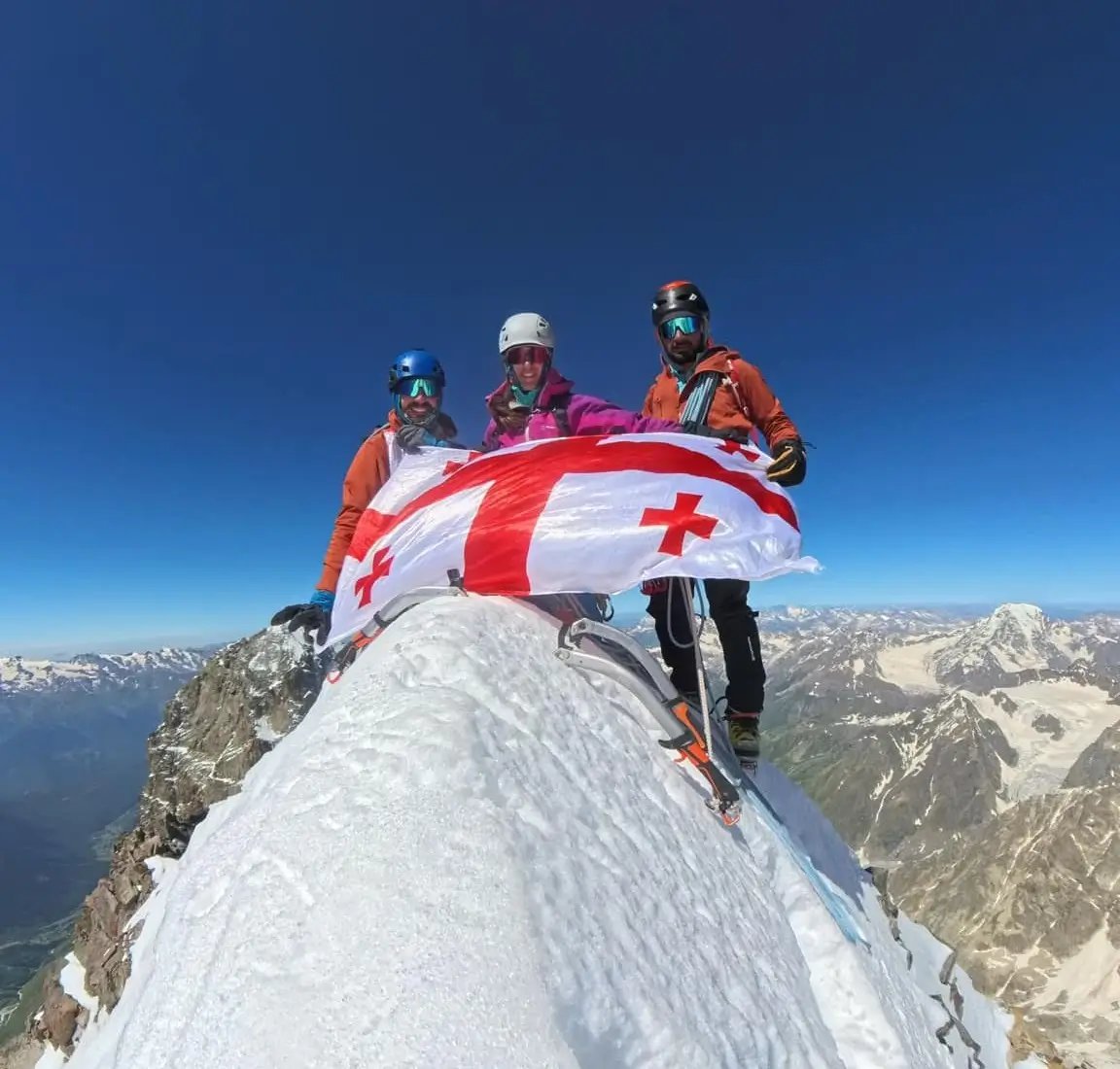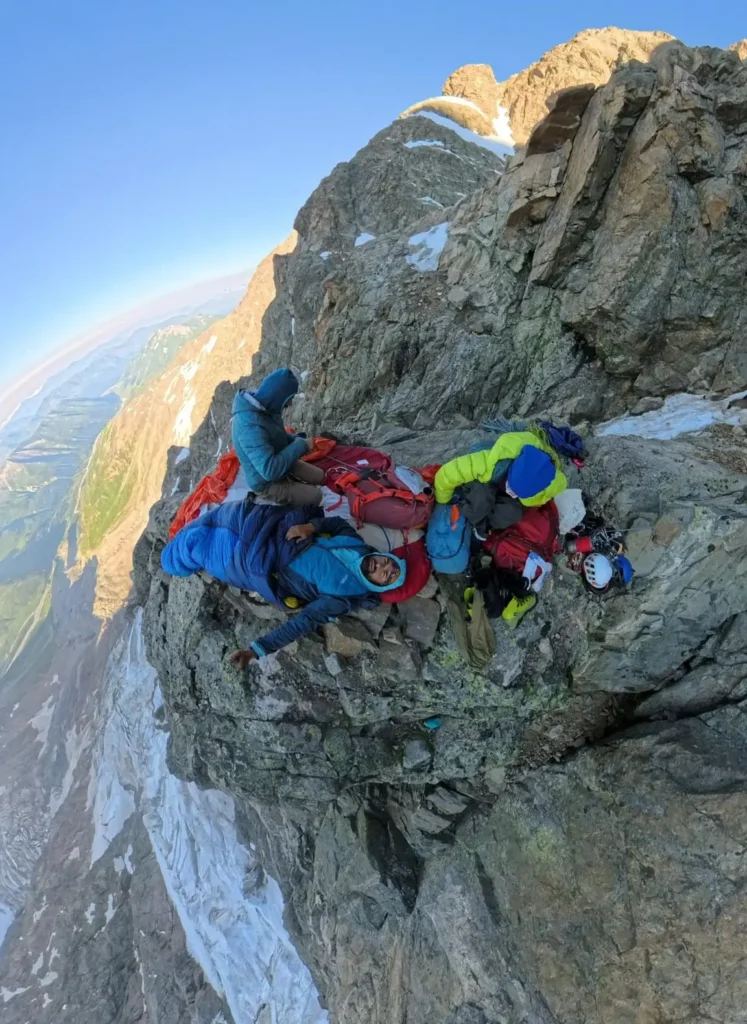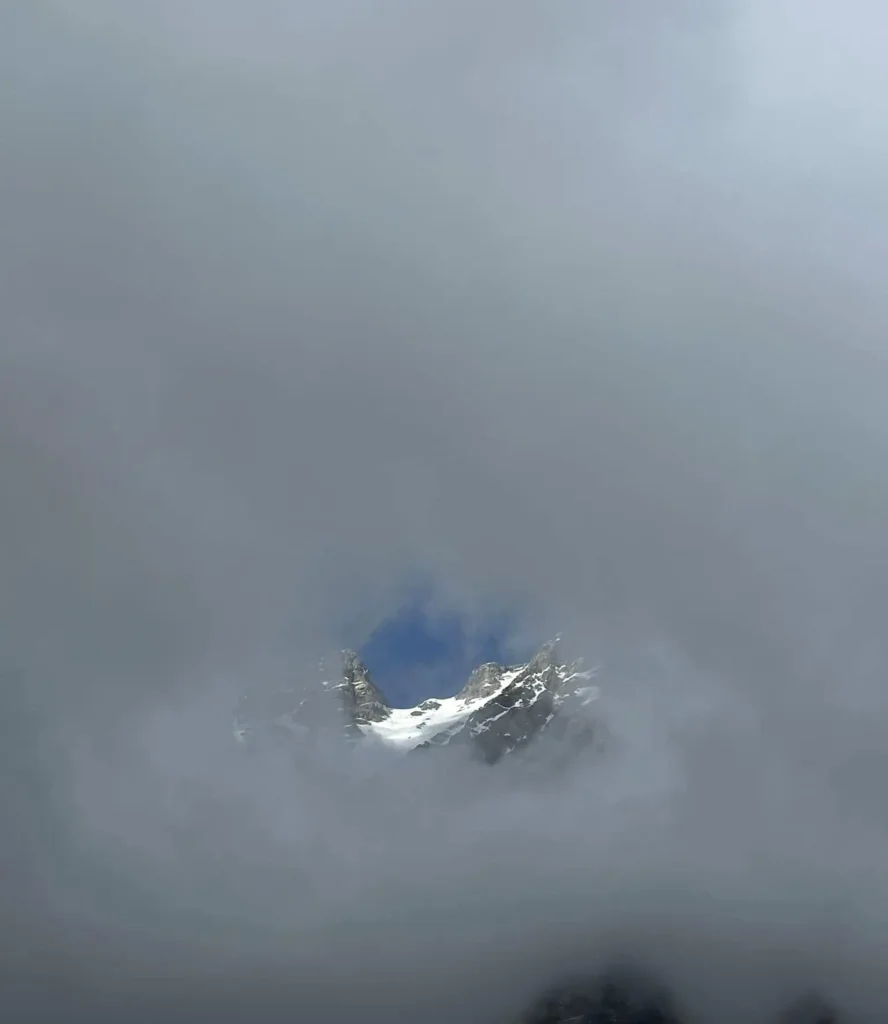Georgian Team’s Ascent to Ushba and Shkhara’s Edge
In the highlands of Svaneti, two mountains stand as tests of skill, endurance, and spirit: Ushba, the “Matterhorn of the Caucasus,” and Shkhara, Georgia’s highest peak. For 24-year-old Levan Mosashvili, they weren’t just points on a map: they were milestones in a journey that began years earlier, when a school camp first placed him in sight of Ushba’s twin summits.
This summer, after months of training and years of determination, Levan and his partners, Ramaz Jikia and Nesi Matchavariani set out to turn that childhood vision into reality. What followed was a week of waiting out storms, climbing ice and rock, rationing food, and – learning when to push forward and when to turn back. It’s a story of summits, setbacks, and the quiet resolve to return.

Ushba, Photo: Levan Mosashvili
Table of contents
The Dream That Began in a School Camp
Preparation for the Mountain
Ushba: Waiting, Weather, and the Climb
Rationing Food: The Hidden Challenge
The Shkhara Challenge
Turning Back
Beyond Ushba and Shkhara
The Dream That Began in a School Camp
The idea of climbing Ushba took root in Levan Mosashvili’s mind not in a climbing gym or expedition, but during a childhood school camp. As a student of the private school “Retsa,” he joined annual wilderness trips where tents, rivers, and star-filled skies replaced classrooms and corridors. One summer, “Retsa” organized its Becho camp in Svaneti. It was there that Levan saw Ushba for the first time, its double spire rising into the clouds: “It stayed in my heart from that moment,” – Levan says.
Years later, as he took his first steps into mountaineering, the mountain returned to his thoughts – not as a distant backdrop, but as a personal challenge.
” I told myself, You have to climb Ushba. At first I kept it in my head, but soon I started saying it out loud – with the same confidence Muhammad Ali said he’d be champion. I meant it then, and I still do.”
Building the Team
In 2025, Levan (24) and fellow climber Ramaz Jikia (28) began planning the climb. Arriving in Mestia, they met their friend and fellow mountaineer, Nesi Machavariani (35), who had already attempted Ushba twice that season but had been forced to turn back due to bad weather.
Levan and Ramaz invited her to join them for a third attempt – and this time, to share the partial knowledge she had of the route, particularly useful in the glacier’s maze of crevasses. Nesi accepted.
Preparation for the Mountain
Levan’s training began early in the year. In January, he tackled the Grade 3 route on Mount Kazbek, followed by the same grade on Mount Ortsveri. Later, he joined a technical mountaineering gathering organized by Zurab Kvestadze and the Bravo Club: “At Bravo, I climbed some of the hardest routes I’ve done so far, ” Levan explains. “ By the end, I knew I was ready. ”
It was during the Chaukhi training camp that he and Ramaz solidified their Ushba plan. Ramaz’s projects, submitted to the Georgian Mountaineering Federation, secured funding for the climb. Now, the only step left was to go.
Ushba: Waiting, Weather, and the Climb
Upon arriving in Mestia, the weather was far from perfect. But with a Shkhara climb also on their list, the team decided to seize a short break in the clouds to move directly to basecamp. What they thought might be a brief wait for a clear day turned into a five-day hold in camp, with a total of seven days in the mountains. They endured rain, hail, and snowstorms.
Finally, on the sixth day, a small weather window opened.
They ascended Ushba via the classic route – a climb that combines extensive ice work with demanding technical sections.
On July 23, 2025, the years-long vision became reality.
“When I reached the summit, I realized I was ready for bigger goals,” says Levan. “This was just one mountain, but the journey showed me new heights inside myself.”
Rationing Food: The Hidden Challenge
One of the hardest parts of the expedition, Levan says, wasn’t the technical difficulty – it was food management. They had packed rations for only three days, but the expedition stretched to seven.
“We measured what we had every day, making sure we’d still have enough strength for the final push,” Levan explains.
Every day, the team carefully calculated what they had left and how much they could afford to consume – without compromising their energy for the final summit push. It was a lesson in planning, adaptation, and survival.

Volcanic mountains form from eruptions that deposit layers of lava and ash over time. Some are extinct, while others are still active or dormant, posing additional risks.
The Shkhara Challenge
Levan’s Svaneti expedition didn’t end with Ushba. His sights were also set on Shkhara – the highest peak in Georgia.
For this climb, the entire team was in unfamiliar territory. Their only guide was a single photograph of the route, a thin line traced over the face. Navigating by constantly checking the image on a phone, they broke trail, sometimes backtracking after realizing a chosen path was impassable.
The ascent to Shkhara included Levan and Ramaz, but not Nesi. Instead, Mariam Gelashvili was part of the team. It’s important to note that Mariam, along with her climbing partner Maia Sitchinava, became the first women to independently ascend North Ushba in 2024. These two Georgian women shared the power of this glorious mountain, embodying the importance of love and respect for nature, showing how trust towards the mountains feeds willpower.
One of Shkhara’s unique difficulties is that every camp must be reached with full packs. The approaches are often steep rock climbs in themselves.
“It’s not just carrying weight,” Levan says. “It’s climbing rock with a heavy load. It takes time, it takes energy, and it tests you in every way.”
When no suitable campsite existed, they manually leveled small patches with loose stones to pitch tents. In many cases, exposed terrain made this impossible. On those nights, they slept on top of the tent rather than inside, roped into anchors for safety, never removing their harnesses.
“Every night, we slept tied into the ropes. Around us, there was nothing but vertical drops.”
Turning Back
By day four, the route entered deep snow at about 4,300 meters. Trail-breaking through waist-deep drifts drained time and energy. With heavy rain forecast, their summit window had vanished.
The team decided to turn back. On the descent, they were caught in continuous thunderstorms, with lightning and thunder so intense Levan says he’d never seen anything like it in the mountains.
“Even then, and even more now looking at the weather, I know it was the right decision. And the most important thing is – we’ll return.”

Shkhara, Photo: Levan Mosashvili
Beyond Ushba and Shkhara
In just two climbs – one completed, one turned back – the team experienced the full spectrum of mountaineering: the exhilaration of a hard-won summit, the grind of rationing food and energy, the tension of sleeping roped in above sheer drops, and the discipline to retreat in the face of incoming storms.
Ushba tested their skill. Shkhara tested their judgment. Both demanded patience, strength, and trust in one another.
For Levan Mosashvili, Ramaz Jikia, and Nesi Machavariani, the 2025 season in Svaneti was never about collecting summits, it was about confronting the mountains on their own terms, taking what they gave, and knowing they’ll be back for more.
Because in the high Caucasus, success isn’t just measured in meters climbed, but in the stories, lessons, and bonds carried down from the heights.
